Playtime at the Pavilions: Carmody Groarke at Dulwich
Picture Gallery
After Peter Cook’s temporary play pavilion at the Serpentine Gallery, Dulwich Picture Gallery have followed with an altogether more permanent for artlovers of all ages. Rob Fiehn went along to have a play & look at how it was all put together.
As a north Londoner, I know exactly how many times I’ve
visited the Dulwich Picture Gallery: three. The first was to attend the opening
reception of a temporary pavilion designed by the young practice IF_DO, which
was part of the London Festival of Architecture in 2017. It was a strikingly
large structure, but it felt light thanks to its crisscrossing timber beams and
mirrored panels that played clever tricks with views of the surrounding
landscape and the gallery’s brick façade.
I went back two years later for the next pavilion in the series, this one by the then-emerging designer Yinka Ilori, working with Pricegore. This was a different beast altogether. It was bigger, brighter and heavier, with an elevated walkway wrapped in colourful batons inspired by Lagos textiles. My young son loved it, spending a whole afternoon racing up, down and around the structure. It was playful and inviting, which is an aspect that the gallery clearly values for its audience.
![]()
![]()
Fast forward six years and a ‘pavilion’ has returned to Dulwich, this time as a permanent fixture. The ArtPlay Pavilion is the creation of Carmody Groarke, a studio appropriately known for their temporary projects, including the Filling Station at King’s Cross and the skeletal “big box” that currently shelters Charles Rennie Mackintosh’s Hill House. Their new box in Dulwich represents a refined presence in the landscape, with grey exterior walls, oversized circular windows and slim metal canopies that project out from the roof. It has quickly become a gathering spot for high-end buggies and prams (perfectly colour-coordinated, of course), belonging to the space’s primary audience: parents and their under-eights. The whole thing feels tasteful and carefully considered.
Inside, however, is a different story. Upon entering, a dreamlike world unfolds, designed by artists Sarah Marsh and Stephanie Jefferies of HoLD Collective. Where the exterior is almost austere, the interior is a fantastical landscape, with soft furnishings, cloud and trumpet motifs on the walls, slides and a bridge inspired by the Canaletto painting hanging in the neighbouring gallery. It’s a multisensory space meant to spark creativity, though it is easily the poshest soft play I’ve ever encountered. I found myself nervously watching the children explore the space, worrying about sticky fingers that might brush a little too close to the exquisite embroidery by the duo behind this immersive work.
![]()
![]()
Sitting later in the newly extended family café, overlooking the just-opened Sculpture Garden, I found myself appreciating the Dulwich Picture Gallery’s investment in its estate. The pavilion’s Douglas fir frame is low-carbon but designed to last, not vanish at the end of a single season. Its high-quality build and beautiful interior will no doubt become well-loved and well-used over time. And, crucially, the interior is flexible enough to be reconfigured as needs change, representing a kind of future-proofing that seems rare in a lot of the proscribed spaces found in cultural architecture.
![]()
![]()
This is a striking contrast to a similar architectural sojourn this summer: a trip to visit the Serpentine Pavilion(s) in central London. Marina Tabassum’s translucent shell is a dramatic spectacle, perfect for drawing summer crowds, but it felt strangely empty, with a primary focus of hosting cocktail receptions. Despite the fact that the Serpentine Pavilions only hold a temporary residency in Hyde Park, the gallery is very good at finding new homes for its six-month experiments. Unfortunately, they often disappear into private collections, cutting off public access. This year, the pavilion was joined by a temporary play structure in the form of a bright orange LEGO®-lined pod, topped with a geodesic dome, designed by Archigram founder Peter Cook (00277). It was fun, magnetic even, and covered with children throughout its opening hours. It was, however, much flimsier than its neighbour and dismantled after only two months. Whether it will have a second life or be scrapped is unclear.
![]()
![]()
![]()
All of which raises the question: have we moved beyond the age of the temporary pavilion? They certainly have the power to transform a cultural venue into a ‘destination’ for the period that they exist but their social impact appears to be more limited in an age of limitless pop-up shops and restaurants. The Serpentine Pavilion once felt radical thanks to deconstructivist structures, inflatable canopies and fake boulders hovering in the landscape. They would offer us a taste of what architecture could be but now we seem limited to tasteful sun shades for the consumption of tea and cake.
The ArtPlay Pavilion seems to point us in a new direction where lightweight architecture is less about one-off spectacle and more about building lasting cultural infrastructure. Dulwich and its design team have created something that is both loose-fit and long-life, a space that will continue to evolve and delight without the wastefulness of building and dismantling each season. It’s a model that balances environmental responsibility, community benefit and design ambition. Perhaps this is a challenge to other galleries: to fundraise not just for the next summer crowd-pleaser, but for the kind of space that will still be welcoming visitors, children included, for many years to come.
![]()
I went back two years later for the next pavilion in the series, this one by the then-emerging designer Yinka Ilori, working with Pricegore. This was a different beast altogether. It was bigger, brighter and heavier, with an elevated walkway wrapped in colourful batons inspired by Lagos textiles. My young son loved it, spending a whole afternoon racing up, down and around the structure. It was playful and inviting, which is an aspect that the gallery clearly values for its audience.
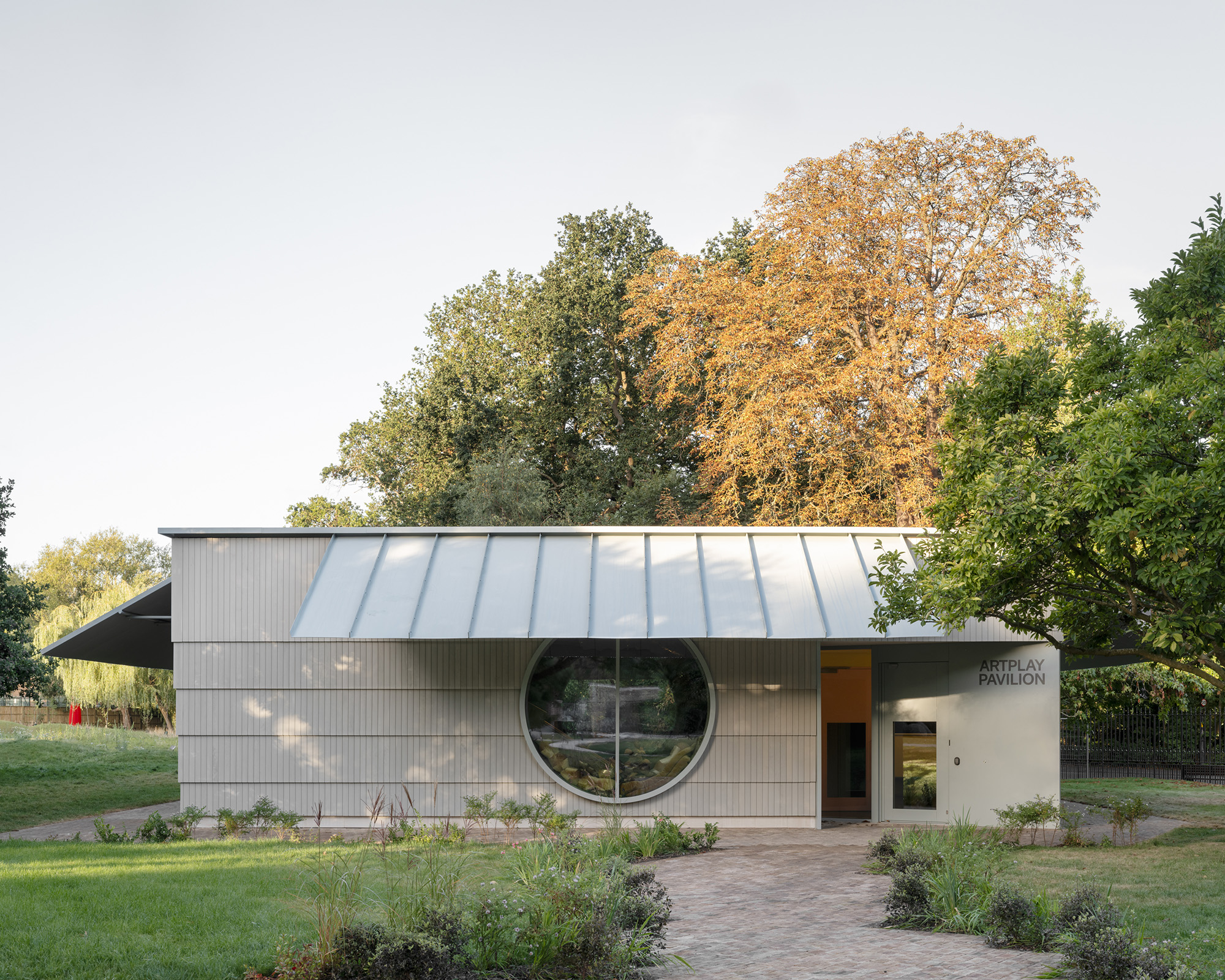
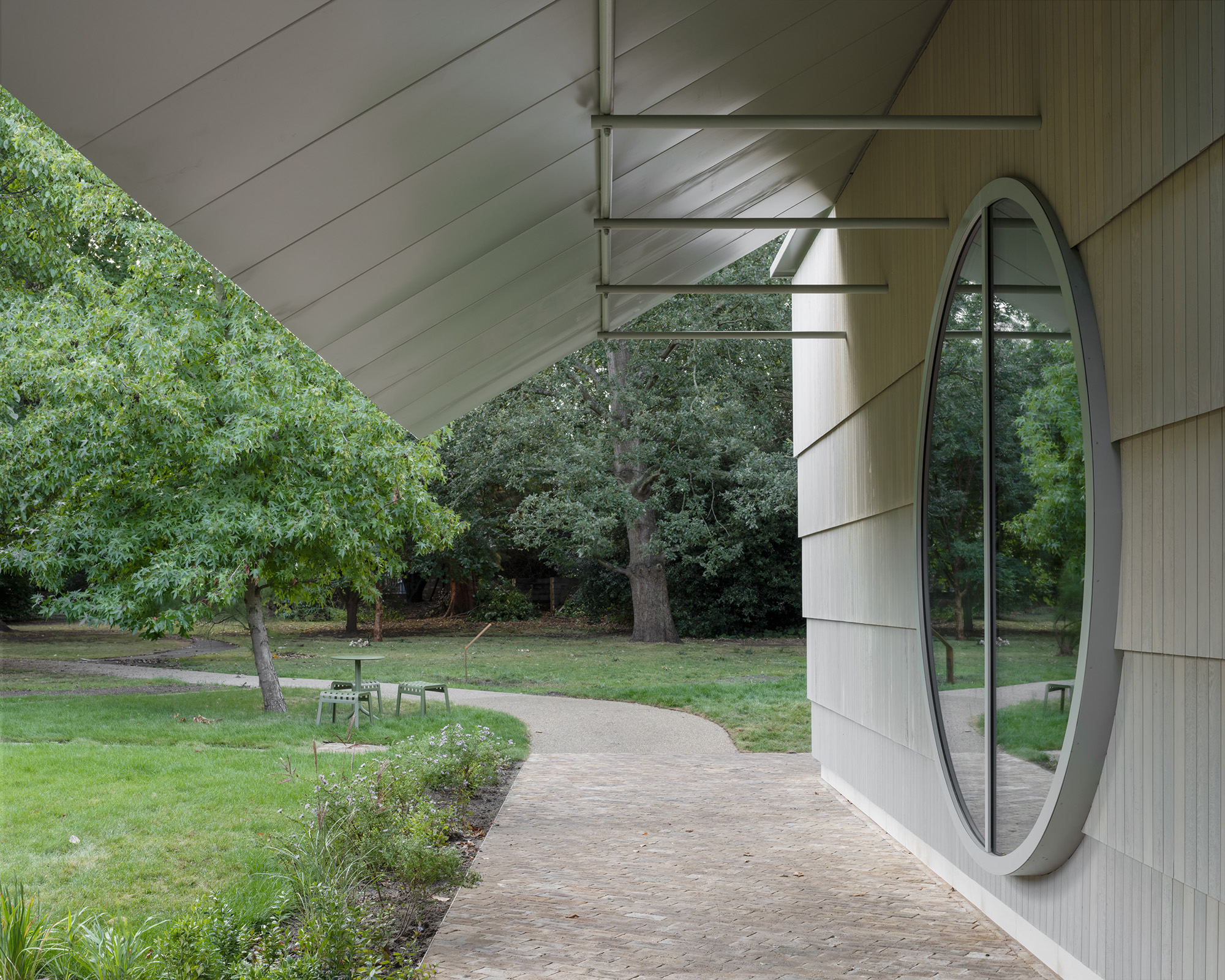
Fast forward six years and a ‘pavilion’ has returned to Dulwich, this time as a permanent fixture. The ArtPlay Pavilion is the creation of Carmody Groarke, a studio appropriately known for their temporary projects, including the Filling Station at King’s Cross and the skeletal “big box” that currently shelters Charles Rennie Mackintosh’s Hill House. Their new box in Dulwich represents a refined presence in the landscape, with grey exterior walls, oversized circular windows and slim metal canopies that project out from the roof. It has quickly become a gathering spot for high-end buggies and prams (perfectly colour-coordinated, of course), belonging to the space’s primary audience: parents and their under-eights. The whole thing feels tasteful and carefully considered.
Inside, however, is a different story. Upon entering, a dreamlike world unfolds, designed by artists Sarah Marsh and Stephanie Jefferies of HoLD Collective. Where the exterior is almost austere, the interior is a fantastical landscape, with soft furnishings, cloud and trumpet motifs on the walls, slides and a bridge inspired by the Canaletto painting hanging in the neighbouring gallery. It’s a multisensory space meant to spark creativity, though it is easily the poshest soft play I’ve ever encountered. I found myself nervously watching the children explore the space, worrying about sticky fingers that might brush a little too close to the exquisite embroidery by the duo behind this immersive work.
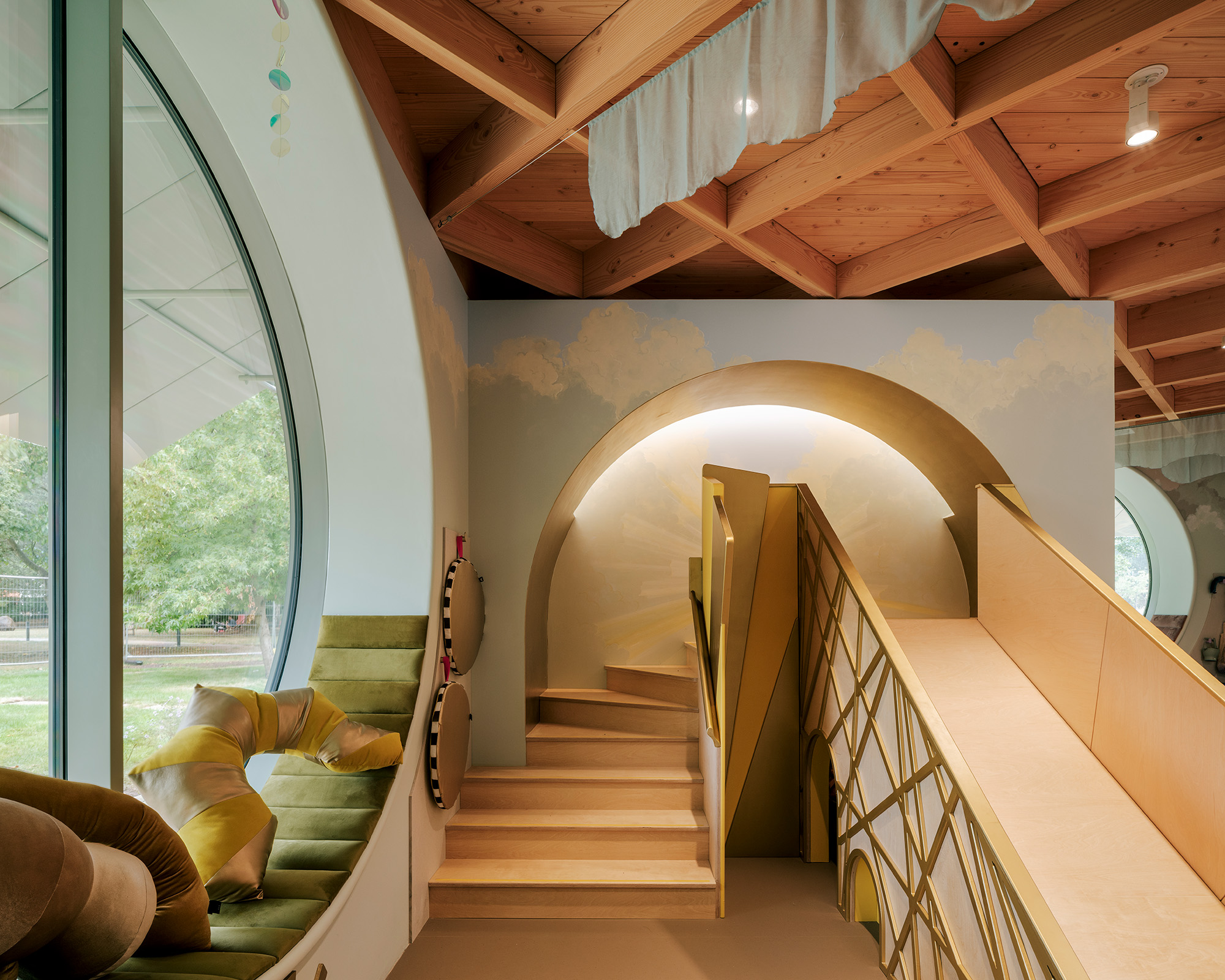
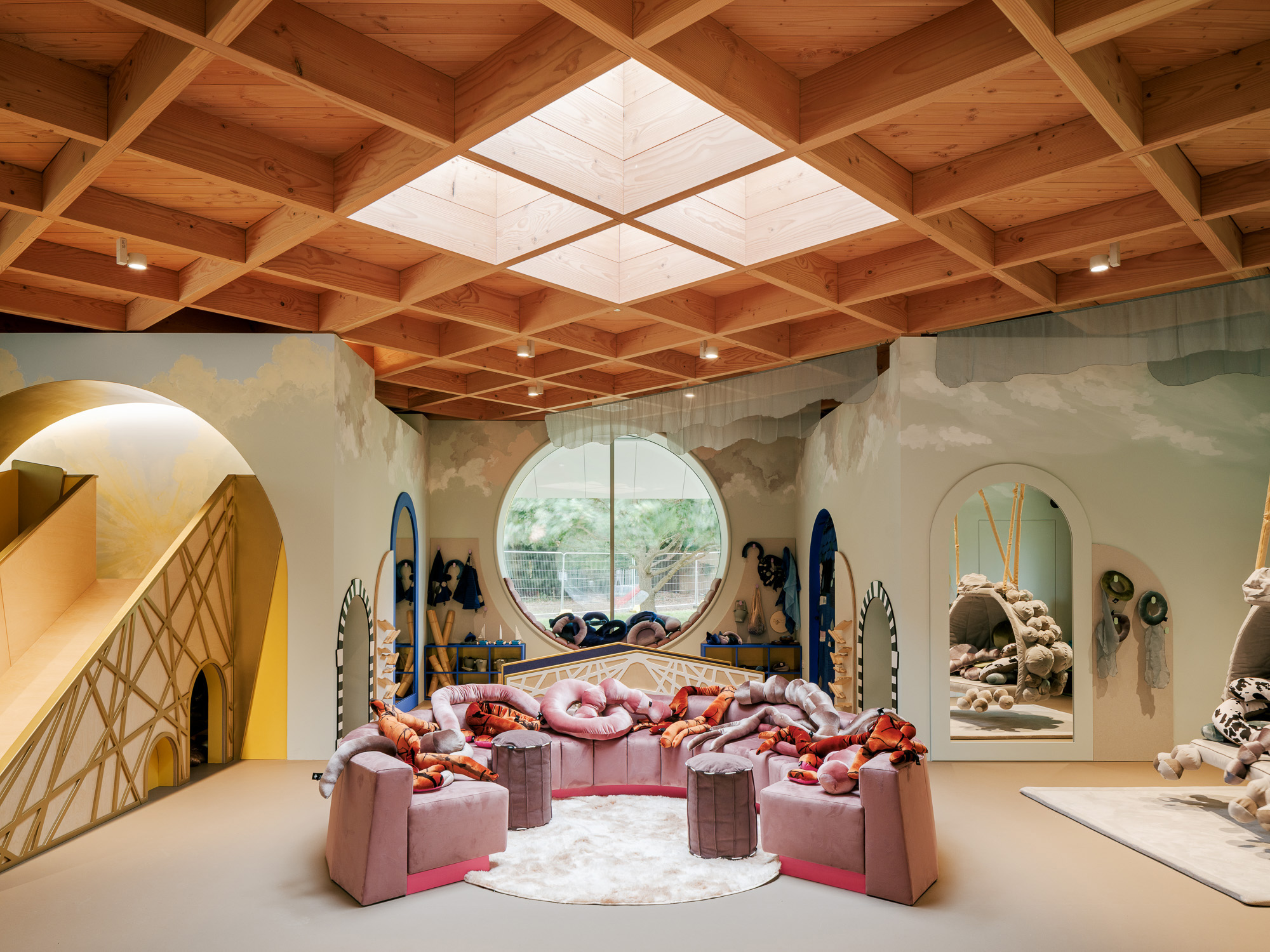
Sitting later in the newly extended family café, overlooking the just-opened Sculpture Garden, I found myself appreciating the Dulwich Picture Gallery’s investment in its estate. The pavilion’s Douglas fir frame is low-carbon but designed to last, not vanish at the end of a single season. Its high-quality build and beautiful interior will no doubt become well-loved and well-used over time. And, crucially, the interior is flexible enough to be reconfigured as needs change, representing a kind of future-proofing that seems rare in a lot of the proscribed spaces found in cultural architecture.
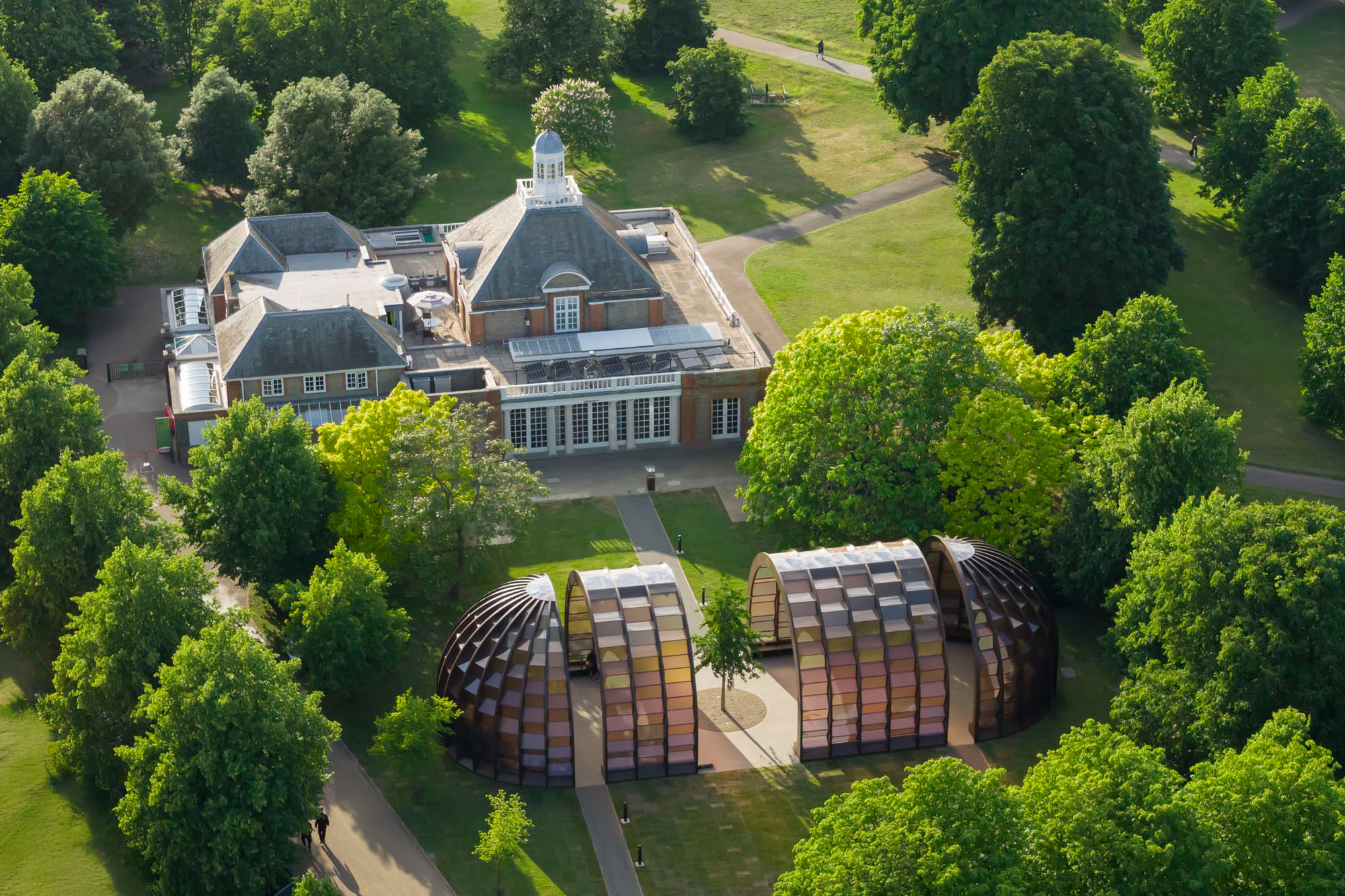
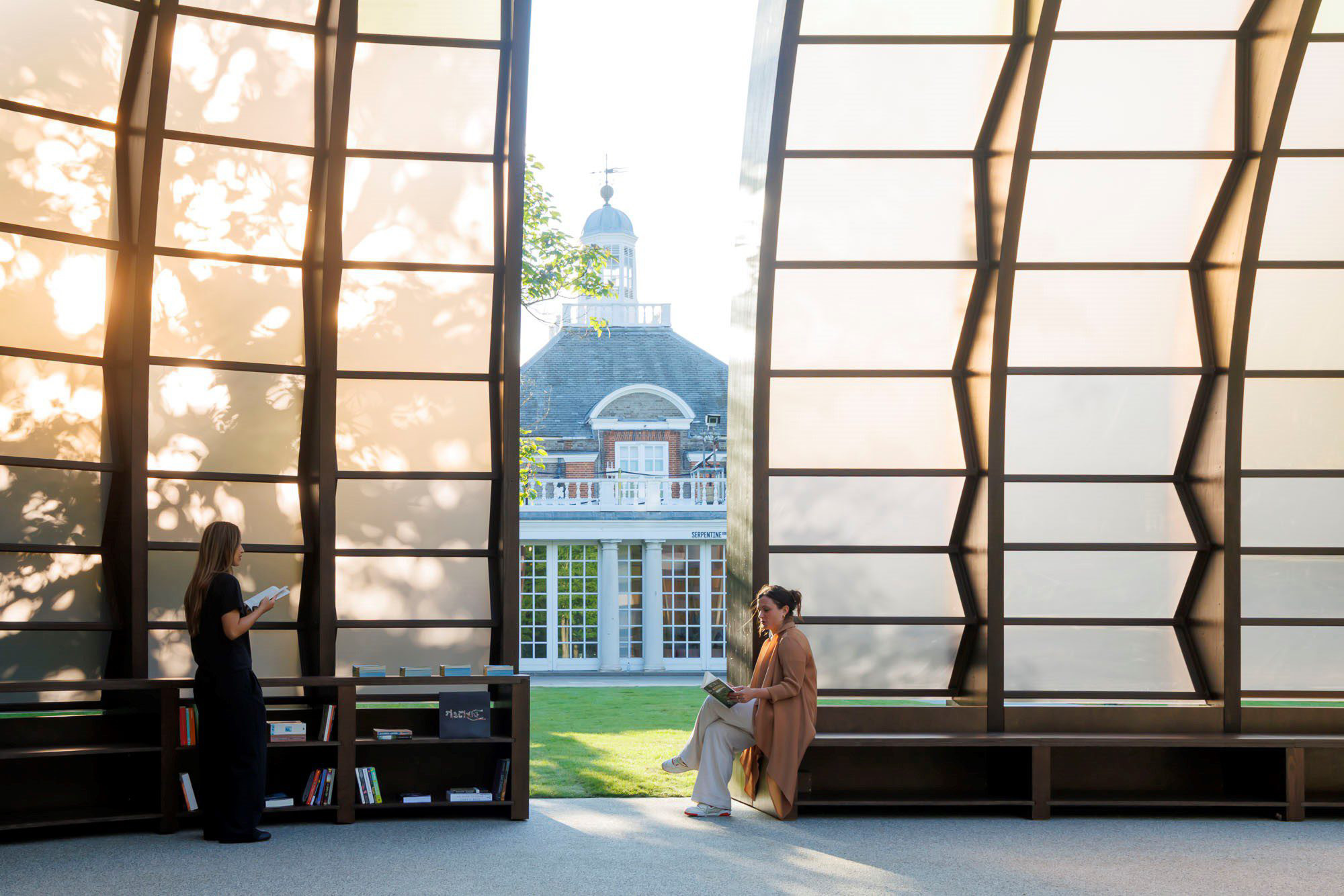
This is a striking contrast to a similar architectural sojourn this summer: a trip to visit the Serpentine Pavilion(s) in central London. Marina Tabassum’s translucent shell is a dramatic spectacle, perfect for drawing summer crowds, but it felt strangely empty, with a primary focus of hosting cocktail receptions. Despite the fact that the Serpentine Pavilions only hold a temporary residency in Hyde Park, the gallery is very good at finding new homes for its six-month experiments. Unfortunately, they often disappear into private collections, cutting off public access. This year, the pavilion was joined by a temporary play structure in the form of a bright orange LEGO®-lined pod, topped with a geodesic dome, designed by Archigram founder Peter Cook (00277). It was fun, magnetic even, and covered with children throughout its opening hours. It was, however, much flimsier than its neighbour and dismantled after only two months. Whether it will have a second life or be scrapped is unclear.
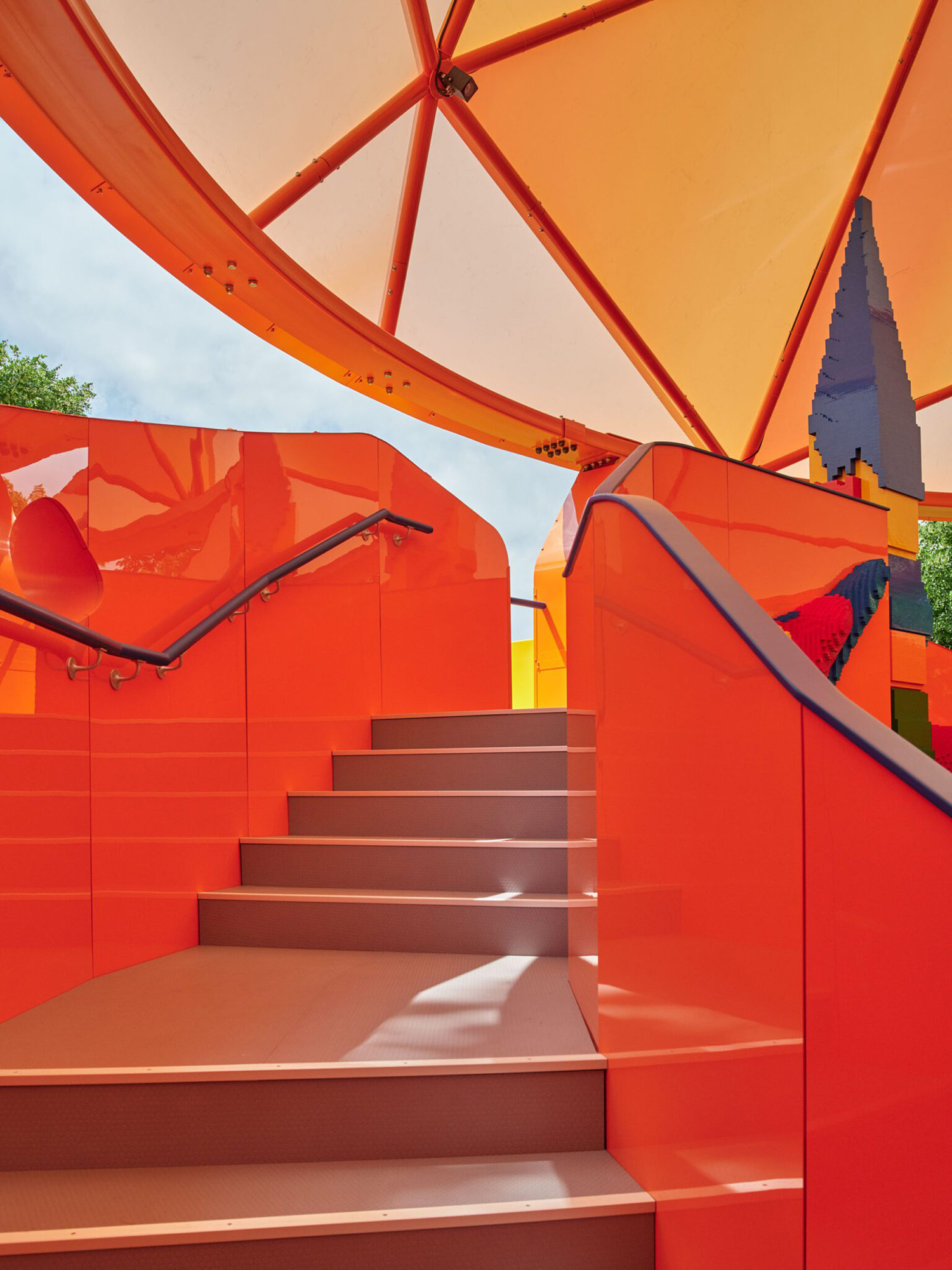
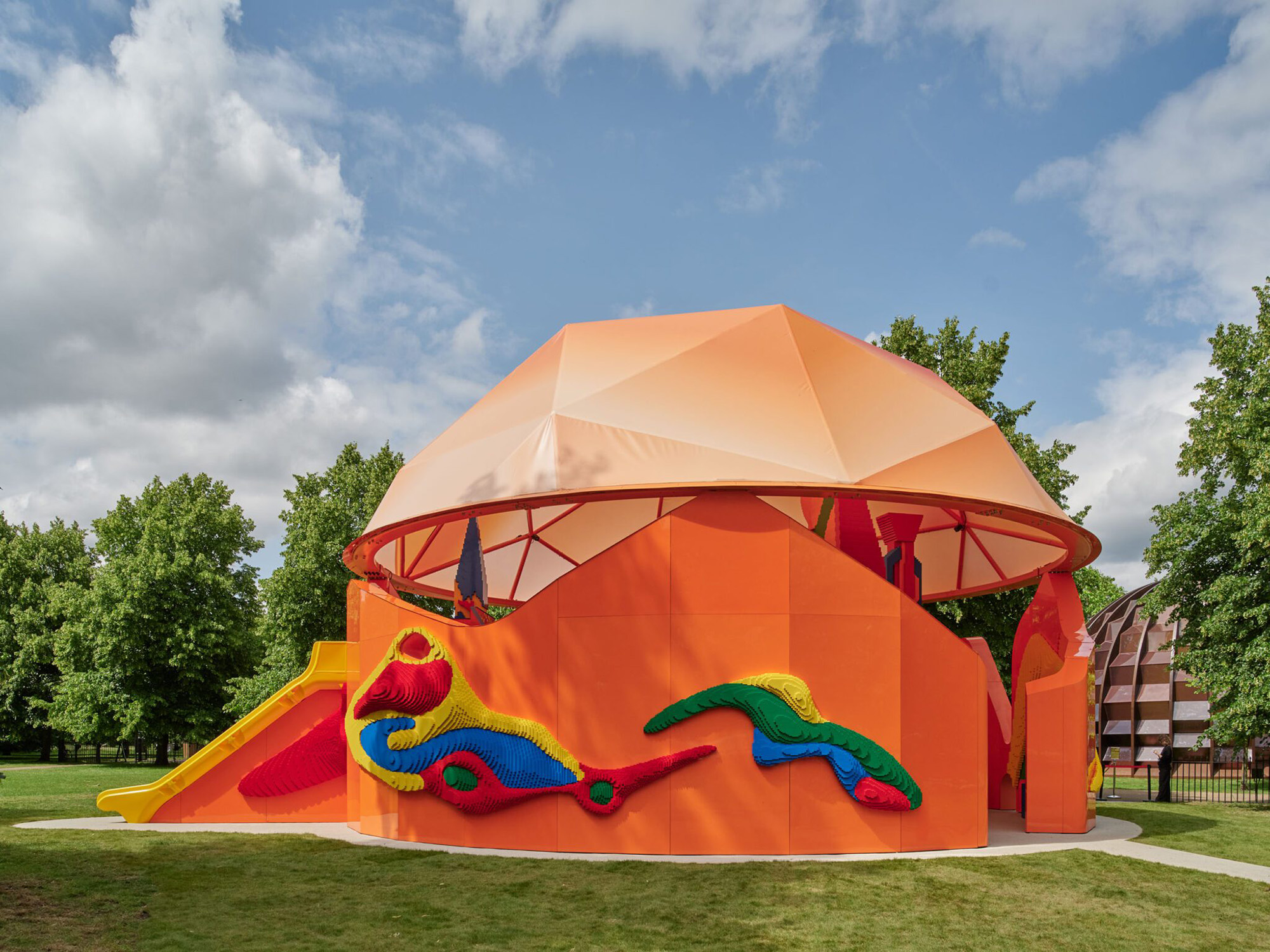
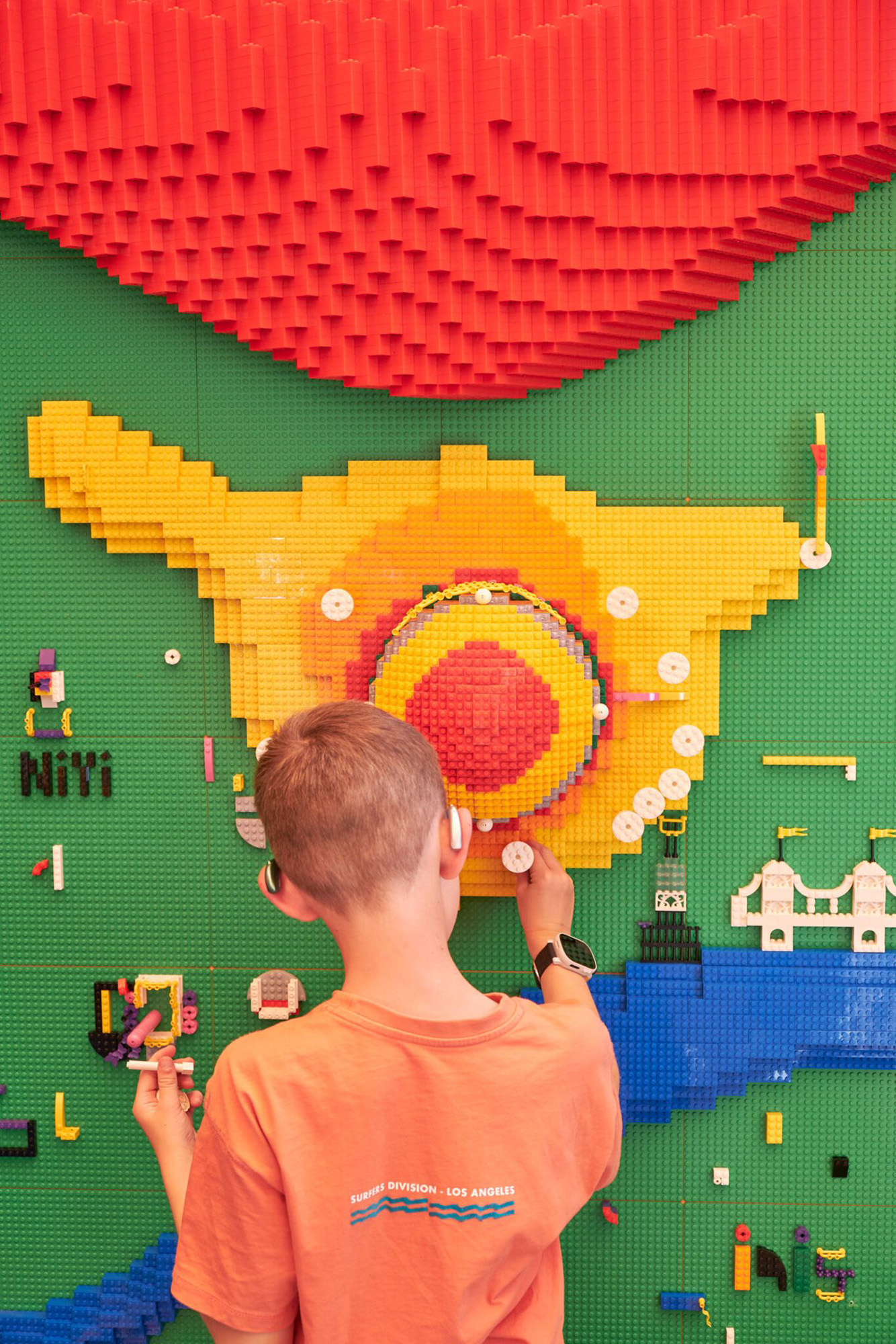
All of which raises the question: have we moved beyond the age of the temporary pavilion? They certainly have the power to transform a cultural venue into a ‘destination’ for the period that they exist but their social impact appears to be more limited in an age of limitless pop-up shops and restaurants. The Serpentine Pavilion once felt radical thanks to deconstructivist structures, inflatable canopies and fake boulders hovering in the landscape. They would offer us a taste of what architecture could be but now we seem limited to tasteful sun shades for the consumption of tea and cake.
The ArtPlay Pavilion seems to point us in a new direction where lightweight architecture is less about one-off spectacle and more about building lasting cultural infrastructure. Dulwich and its design team have created something that is both loose-fit and long-life, a space that will continue to evolve and delight without the wastefulness of building and dismantling each season. It’s a model that balances environmental responsibility, community benefit and design ambition. Perhaps this is a challenge to other galleries: to fundraise not just for the next summer crowd-pleaser, but for the kind of space that will still be welcoming visitors, children included, for many years to come.
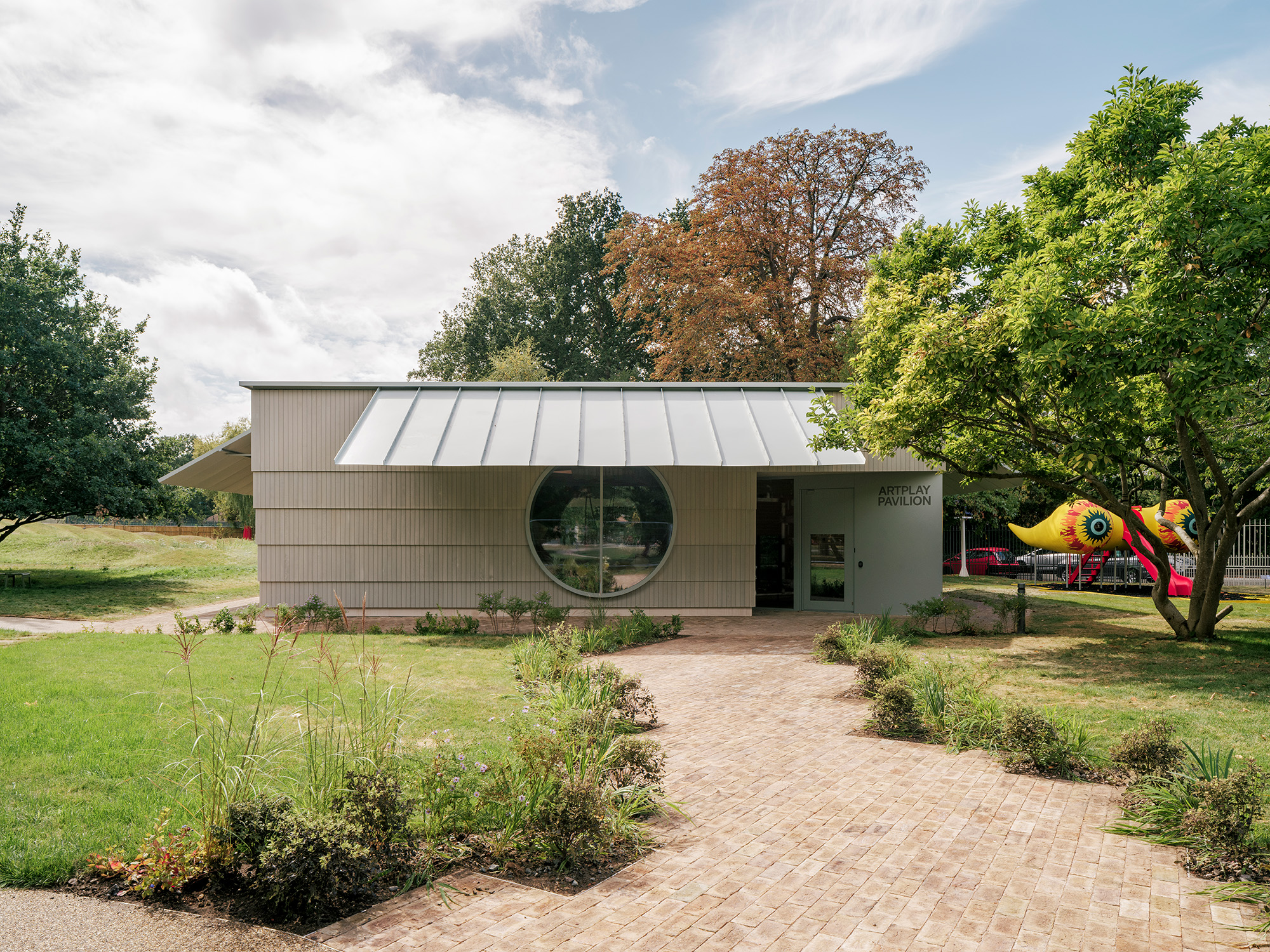
Dulwich Picture Gallery opened its doors over 200 years ago and became the world’s first purpose built public art gallery – a sanctuary in the city, dedicated to sharing one of the greatest art collections in the world, with the world. Like most good ideas, it caught on. And happily, we’re no longer the UK’s only public art gallery. Yet we remain dedicated to our mission of unlocking art for all. From historic paintings to contemporary sculpture, we’re committed to bringing art to life and life to art. Finding new and surprising ways for people to enjoy, appreciate, and be inspired by great art – inside and out.
www.dulwichpicturegallery.org.uk
Carmody Groarke is a London-based architectural practice founded in 2006 by Kevin Carmody and Andy Groarke. The practice has developed a reputation for working internationally on a wide range of arts, cultural, heritage and residential projects. Completed work includes the critically acclaimed Windermere Jetty Museum in the Lake District, a temporary shelter for Charles Rennie Mackintosh’s Hill House in Scotland and a new gallery for the Science and Industry Museum in Manchester. Current projects include a major refurbishment and extension to the national Design Museum Gent in Belgium, a masterplan for the British Library in Yorkshire with a major new archive building for the national collection and the Bibliothèque nationale de France Conservation Centre in Amiens, France.
Carmody Groarke’s work has been recognised through several prestigious architectural awards, including most recently being shortlisted for the EU Mies van der Rohe Award, the 2021 RIBA Building of the Year Stirling Prize, the Civic Trust National Panel Special Award 2020, the Architects’ Journal Building of the Year 2019 and Building Design Architect of the Year 2018. Four monographs of the practice’s work have been published by El Croquis, 2G, AMAG and A+U.
www.carmodygroarke.com
HoLD Collective is formed of dynamic artistic duo
Sarah Marsh and Stephanie Jefferies whose respective specialisms inform their collective practice. Art that you can hold or be held within, endeavours to challenge and disrupt hierarchical divisions between art and engagement. The sensitivity of their practice can be felt in their work; developing interactive, sensory spaces and resources with organisations including Tate Modern, Tate Britain, Whitechapel Gallery, Whitworth Art Gallery, Manchester Art Gallery, Yorkshire Sculpture Park and The Hepworth Wakefield.
Rob Fiehn is a London-based communications consultant specialising in architecture and design. He is also chair of the Museum of Architecture, a London Society committee member and sits on the board of the Blackhorse Workshop in Walthamstow. Rob has edited a number of books, including the recent Collective Action!: The Power of Collaboration and Co-Design in Architecture, published by RIBA Books.
www.robertfiehn.com
Carmody Groarke’s work has been recognised through several prestigious architectural awards, including most recently being shortlisted for the EU Mies van der Rohe Award, the 2021 RIBA Building of the Year Stirling Prize, the Civic Trust National Panel Special Award 2020, the Architects’ Journal Building of the Year 2019 and Building Design Architect of the Year 2018. Four monographs of the practice’s work have been published by El Croquis, 2G, AMAG and A+U.
www.carmodygroarke.com
HoLD Collective is formed of dynamic artistic duo Sarah Marsh and Stephanie Jefferies whose respective specialisms inform their collective practice. Art that you can hold or be held within, endeavours to challenge and disrupt hierarchical divisions between art and engagement. The sensitivity of their practice can be felt in their work; developing interactive, sensory spaces and resources with organisations including Tate Modern, Tate Britain, Whitechapel Gallery, Whitworth Art Gallery, Manchester Art Gallery, Yorkshire Sculpture Park and The Hepworth Wakefield.


